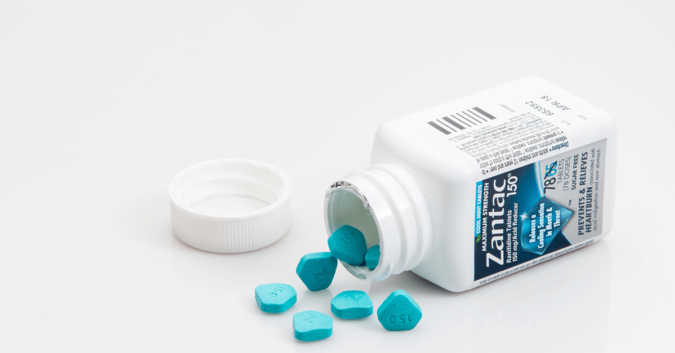Photo credit: Terry Putman – Shutterstock.com
Is Zantac safe? The popular brand-name stomach medication is included in a recent safety alert from the Food and Drug Administration (FDA). The agency is warning consumers that some ranitidine medications have tested positive for low levels of a toxin that may cause cancer in humans.
Ranitidine is the name for the active ingredient in Zantac and other generics that are used by millions of people to treat and prevent gastrointestinal issues. Known as a histamine-2 blocker, ranitidine decreases the amount of acid created by the stomach. Depending on the strength, ranitidine medications may be prescription or over-the-counter (OTC).
According to the FDA, patients should continue taking ranitidine medications and “trust that their medicines are safe.” Those with concerns about taking prescription ranitidine are advised to talk with their doctor about other treatment options. For those who take the drug OTC, they should find another OTC drug approved for their condition.
“Although NDMA may cause harm in large amounts,” the agency says of the toxin, “the levels the FDA is finding in ranitidine from preliminary tests barely exceed amounts you might expect to find in common foods.”
What Is NDMA? How Did It Get in Medication?
The toxic chemical, known as N-nitrosodimethylamine, or NDMA, is present at extremely low levels in water, meats, and vegetables. At high enough levels, however, NDMA can be dangerous.
There is conclusive experimental evidence that NDMA causes cancer in animals, which is one of the main reasons it is classified as “probably carcinogenic” to humans by the Environmental Protection Agency (EPA) and the International Agency for Research on Cancer (IARC).
Although it was once used in the production of rocket fuel, NDMA is now only produced in small amounts for research purposes. NDMA can also sometimes be created as an unintended byproduct of industrial processes.
Since NDMA wasn’t supposed to be part of Zantac’s manufacturing process, no one working at Sanofi’s drug-making facility screened for it. The drug was then passed on to consumers without anyone spotting the impurity.
Another Case of Cutting Corners?
In the last year, millions of doses of Valsartan, Losartan, and Irbesartan had to be recalled due to evidence that the blood pressure medications were tainted with nitrosamines, like NDMA. The contamination was eventually tracked back to several specific manufacturers in China and India.
In those plants, cost-saving changes to the manufacturing process led to the creation of the toxic byproducts, which eventually wound up in their ingredients. Drugmakers purchased the contaminated ingredients from the manufacturers in Asia, ultimately passing them on to consumers in America.
At present, the FDA is investigating how NDMA got into ranitidine medications. Agency spokesperson Jeremy Kahn told Bloomberg that they believe the contamination process is different for ranitidine than for the heart medications like Valsartan.
So far, ranitidine medications have not been pulled from shelves in America, though some companies, like Mylan and Novartis, have stopped distributing their generic versions.
On September 17, the Federal Institute for Drugs and Medical Devices in Germany issued a statement saying that some countries in the European Union were recalling ranitidine medications made with ingredients from Saraca Laboratories Limited, an Indian pharmaceutical manufacturer.
Sanofi, the maker of Zantac, has not stopped the distribution of their medication. A company spokeswoman told Bloomberg that Sanofi produces the heartburn drug in Mexico and sources its active ingredient from Spain. The FDA has promised to work with pharmaceutical companies and international regulators in order to determine the source and scope of the contamination.
Are Ranitidine Drugs the Problem?
The worldwide effort to contain the spread of tainted medications began when Valisure, a Connecticut-based online pharmacy, reported finding high levels of NDMA in ranitidine drugs.
Because Valisure tests batches of the drugs it sells, the company petitioned the FDA to recall ranitidine drugs, conduct examinations about their safety, and reissue new regulations. According to the company, ranitidine may produce NDMA because of its structure and the chemical interactions that take place in the stomach.
As opposed to simply identifying an impurity present in the drug, Valisure is arguing that the drug is itself carcinogenic to humans. In their petition, they say that there are other medications to treat conditions treated by ranitidine that do not produce NDMA.
The FDA’s Next Move
Whether or not the FDA agrees with Valisure’s research, the agency has a lot of work to do when it comes to carcinogens in consumer products. The FDA inspects less than 1% of the drugs that come into America. As global supply chains stretch into new areas further, the agency’s ability to provide sufficient oversight is being tested.
After all, it was not the FDA who first alerted the public about NDMA in Zantac. More and more, it seems, dangerous drugs are being identified by consumers long after they have passed screening from the FDA.
Protecting public health in the 21st century comes with new challenges. Hopefully, the FDA will be able to adapt before more people are exposed to carcinogens like NDMA, which present very serious risks.
